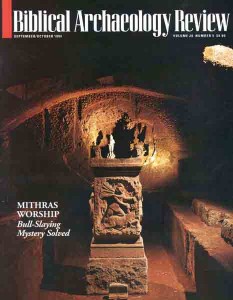Biblical Archaeology Review, September/October 1994
Special Section
Was It an Essene Settlement?
Scholars disagree about the nature of the settlement known as Qumran, which is set in the midst of the area where the Dead Sea Scrolls were found. Roland de Vaux, who directed the excavations at Qumran between 1951 and 1956, concluded that it had been inhabited by...Read more ›
A Hub of Scribal Activity?
Inkwells from Qumran are of more than insouciant interest. These inkwells bear intimately on several important questions—whether Dead Sea Scrolls were written at Qumran, the nature of the Qumran settlement (religious community, winter villa, military fortress or commercial entrepôt), the relationship (if any) between the Qumran settlement...Read more ›
Features
Solving the Mithraic Mysteries
Mithraism, one of the most widespread mystery religions of the Roman empire, arose in the Mediterranean world at exactly the same time as Christianity. Each religion held at its core the belief in a god whose powers and domain lay beyond the boundaries of the cosmos. Because...Read more ›
Exodus Itinerary Confirmed by Egyptian Evidence
The Exodus from Egypt, followed by the invasion and conquest of Palestine, lies at the heart of the Biblical account of Israel’s origins. A number of modern scholars, however, reject the entire story. It is, in their view, little more than a pious fabrication...Read more ›
Archaeology’s Dirty Secret
What may turn out to be a historic meeting took place at Lehigh University last May. Eight senior scholars convened to face what one participant called the profession’s “dirty secret”: Archaeologists love to dig, but hate to write publication reports. As a result, final reports are lacking...Read more ›

